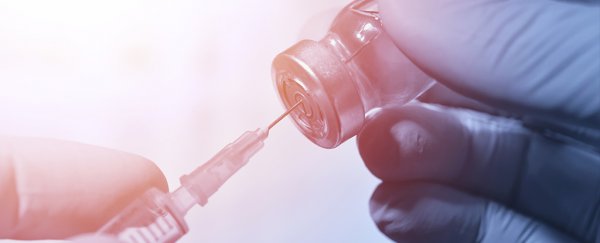A coronavirus vaccine is a theoretical treatment that would prepare a person's immune system for a select strain of coronavirus, thereby reducing their risk of infection.
Prior to the COVID-19 pandemic there were no vaccines for the notable human coronavirus strains SARS-CoV-1, MERS, or SARS-CoV-2.
As of November 2020, there are two promising candidate vaccines that have demonstrated safety and efficacy in clinical trials; one produced by the US-owned multinational Pfizer, and a second produced by another US therapeutics company, Moderna.
How are human coronavirus vaccines being developed?
A vaccine works by providing an immune system with material it can use to set up an effective response against a specific pathogen much faster than usual, preventing invading particles from developing into an infection.
In the past, vaccines were based on pathogens grown in animals, or in eggs, before being harvested and weakened to prevent them from growing into an infection. These dead or injured disease particles could then be injected into a host, often with added ingredients to help kick the immune system into action.
This process can be slow and potentially risky. Developing a vaccine today requires researchers to identify which components will be recognisable enough to an immune system to trigger it into activating without generating serious side-effects or giving rise to debilitating symptoms.
To ensure a high level of efficacy and safety, researchers now tend to start by studying the genome and chemical characteristics of the pathogen.
Recombinant vaccines, for instance, involve isolating sections of the genome that encode a single piece of the pathogen and combining it with a cell culture to produce sufficient material for a vaccine.
An RNA vaccine is an even more recent technology. It involves inserting a similar section of genome in the form of RNA directly into a target's body, using their own cells to produce a piece of the pathogen for the immune system to recognise.
While RNA vaccines allow for rapid testing of various antigens for safety and efficiency, they can be slower to mass produce, relying on new infrastructure to manufacture in large amounts.
Why are coronavirus vaccines so new?
While there are vaccines for several types of coronavirus that typically infect livestock, such as porcine respiratory CoV, a vaccine for the more notorious strains that impact humans has been difficult to develop.
Research into a vaccine to prevent infections by the coronavirus SARS-CoV-1 commenced soon after the 2003 outbreak of severe acute respiratory syndrome (SARS). With the strains responsible for SARS and MERS no longer a global threat and costs for testing so high, interest in (and funding for) coronavirus vaccines quickly subsided after the 2003 outbreak.
In spite of repeated attempts over the years to develop a preventative treatment, no candidate for a human coronavirus vaccine was found to be both safe and effective in preliminary clinical trials until the second half of 2020. Since the global spread of the novel coronavirus, SARS-CoV-2, interest in finding a coronavirus vaccine once again spiked.
The first vaccines set to promise approval for use by a federal health agency are both mRNA vaccines.
Jointly developed by Pfizer and BioNTech, the first to hit headlines claimed to be 90 percent effective. A second trialled by Moderna was found to be 94 percent effective.
Both are expected to be submitted to the US Food and Drug Administration for approval via an emergency authorisation process, with high risk members of the community receiving first doses as soon as December 2020.
All articles are determined by fact checkers to be correct and relevant at the time of publishing. Information published on the coronavirus during the 2020 COVID-19 pandemic may be updated frequently to reflect the dynamic nature of current understanding.
